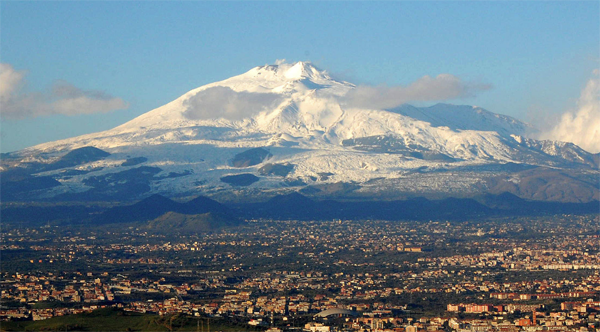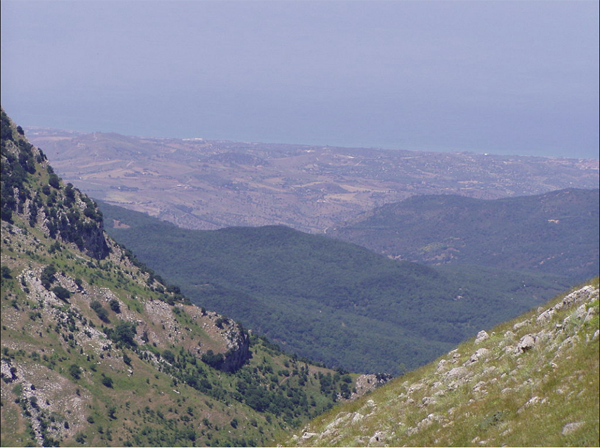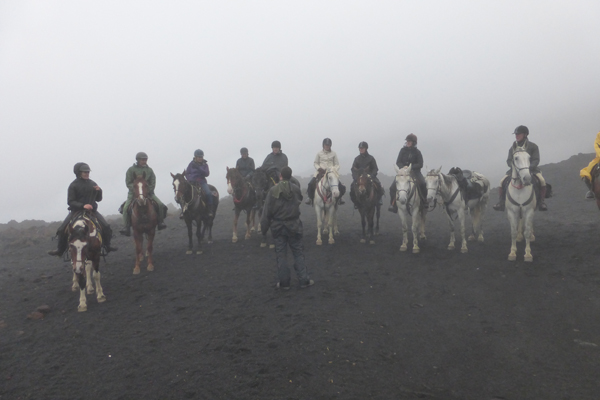Ride to Mount Etna: Exploring Sicily on Horseback
USEF judge and author Ann Jamieson recounts a once in a lifetime horseback riding trek across Sicily.
At first, it is far away in the background, seemingly unreachable.

Mount Etna with the city of Catania in the foreground. Photo courtesy Wikipedia.
Mt. Etna, at 10,900 feet above sea level, dominates the east coast of Sicily. Europe’s tallest and most active volcano, it erupts roughly every other year. Despite its many eruptions, it is warmly regarded by Sicilians. The inferno within those eruptions produces volcanic soil, forming the bed of the richest agricultural lands on earth. Thriving at Mt. Etna’s base are orchards of olives, apples and peaches, grape vines, and almond, pistachio, and hazelnut trees.
In addition, Mt. Etna’s eruptions seldom affect those living nearby. Although lava flows wipe out trees and an occasional ski area, no fatalities have been recorded for hundreds of years. Most eruptions occur at the summit, and, although spectacular, rarely threaten the surrounding inhabitants.
This is our goal: Mt. Etna. Starting from Castelbuono, the Transiciliana Ride takes us across Sicily, crossing two nature reserves (Sambuchetti Campanito and Lake Gurrida) and three regional natural parks--Madonie, Nebrodi, and Etna (a UNESCO World Heritage site). Weather permitting, we planned to nearly summit the volcano at a height of 2847 meters. With an ever-changing landscape, we will experience each of the many faces of Sicily.
Trekking through the Sicilian countryside. Photo by Ann Jamieson.
Ten of us embark on this journey: my friend Alice and I from the U.S., a French couple from Marseille, and six Brits who keep us in stitches with their hilarious British wit. Normally led by Franco Barbagallo, founder of “Sicily on Horseback,” the ride is instead guided by his partner Paolo Cricchio. Having injured his ankle, Franco is not up to hours in the saddle.
As one who knows “like his pockets” Nebrodi and Mt. Etna, Franco partnered with Paolo, who contributed his extensive knowledge of Madonie, enabling the two to perform the prodigious feat of putting together a route across Sicily to Mt. Etna. Having hiked, mountain biked, and snowshoed Mt. Etna, Franco is intimately familiar with the volcano.
The trek is a ride only, a tour of the natural features (and tastes) of Sicily. To see the man-made delights of this island, I recommend you schedule some time before or after the ride to visit Palermo (its Palatine Chapel is often named the most beautiful in the world), Agrigento (for its remarkably preserved Greek temples), or Syracuse. Be forewarned though, as the ride description notes, this is a ride suitable only for strong riders in good shape. Not only are you in the saddle for six hours a day, but the riding is often over difficult terrain and can involve long trots and canters.
The tour begins in Castelbuono, where we stay in a restored hermitage, and I enjoy one of the best meals of my life. This trip is not just about the riding, but, as it should be in Italy, is about the food as well. Each meal on the trek consists of four courses: appetizers, pasta, meat entrée and dessert, all based on traditional Sicilian food. Local wines are served.
Chef Vincenzo Antista, who has cooked in major restaurants throughout Europe, begins our meal with a “tortino di patate.” A potato cake. Sounds a bit pedestrian, yet it is anything but. Mashed potatoes are blended with and topped by provola and pecorino cheese and herbs (from local ingredients, as are all the meals on the trip). The result is nothing short of heavenly.
I’m a big fan of risotto, and I have to say, the risotto here is hands down the best I’ve ever eaten--creamy and delicate, yet intense in its flavor and perfectly cooked with no descent into starchiness. It is followed by a lightly breaded, tender pork chop that is off the scales in terms of flavor and texture. The meal alone was worth the trip to Sicily.
Of course, the most important part of a riding tour is the horses, and we couldn’t wait to meet ours. What kind of horse would we ride? And how were these horses uniquely suited to the terrain we would be negotiating? Three types of horses are commonly found in Sicily: the Sanfratellano, the Sicilian Indigenous, and the Sicilian Pure Oriental. Sicily is inordinately proud of its foot-sure native horses, and most of the horses on this ride are Sicilian Indigenous.
Tatarella, my Appaloosa/Sicilian Indigenous mount for our journey. Photo by Ann Jamieson.
Our first morning arrives--a clear, lovely Sicilian day. At the stables, we meet the horses and are matched with the ones we will ride. I ride Tatarella, an Appaloosa/Sicilian Indigenous cross mare. The saddles, specially designed for trekking, are quite comfortable (although seat savers are still highly recommended considering the long hours of saddle time).
Soon we are riding on an ancient Roman trail through Madonie Natural Park. Madonie is home to Sicily’s highest mountain range. Although I know that Sicily is mountainous, the stark and wild beauty of Madonie’s jagged peaks takes me by surprise.
It seems odd to find cars parked high in the mountains on roads that can’t possibly be navigable. Porcini mushroom season, it turns out, is in full swing and mushroom gatherers are seeking their prey. While we spot plenty of porcini, they aren’t the only “fungi” we encounter. Vivid yellow-spotted scarlet mushrooms stand out in the muted woods, and we quickly learn the most important rule of mushroom collecting: eat no red mushroom.

View of Madonie Natural Park in Sicily. Photo courtesy Wikipedia.
High in the mountains, we pause for a photo opportunity. There it is, Etna. We’re covering about 25 miles a day, and we’ve gained on it. It still doesn’t seem possible that in a few days we will ride on it, much less summit this massive mountain.
Due to the area the trek covers, each night’s accommodation varies, ranging from cots in a shared forest preserve shelter, to a modern hotel overlooking Mt. Etna. A lovingly restored villa features the beauty and history of ancient hardware, furniture, and fixtures--blended with modern comforts for the best of both worlds. All are clean and comfortable, with extremely welcoming hosts, and good food is a given.
As we enter “Little Canada” of Sambuchetti Campanito Reserve, we move from mountainous open land to forests, which get thicker as we enter Nebrodi Park. Small cyclamen and crocuses bloom on most of the trails and roads, providing pink and purple patches of color in the darkness of a forest or a muddy stretch of trail. Our horses aren’t the only equines in this wild area. Sicily is home to many free-roaming herds of horses and cattle. The horses, beautiful black Sanfratellano, graze along the trails or stand like statues monitoring our approach.
We are now two days from Etna; the mountain looms large and clear.
The lake area is beautiful, flatter, hilly rather than mountainous. Four lakes: Maulazzo, Biviere, Cartolari, and Tre Arie, comprise a completely different landscape than the mountainsides and forests of the past days. At one point we have to make our way down a steep hill littered with rocks large and small. A landmine, it would seem, for the horses. But truly they have mountain goat stock bred into them; they pick their way carefully through and get us safely down to the lake.
Our gaits vary according to the terrain. At times we walk for lengthy periods on roads or down long hills. At other times we trot for extended periods. A brisk gallop along a ridge populated by wind turbines proves an adrenaline rush for horses and humans alike. As we go through Lake Gurrida Reserve, we have the opportunity for a long canter through springy green pastureland. Despite their long hours, the horses are always keen to go.
Horseshoes suffer short lifespans on these rides due to the pavement, rocks, and hard Roman roads. As Franco says, “the trails eat their shoes.” Paolo, in addition to guide duties, serves as our farrier and sometimes spends lunch hours hunched over horses’ feet.
Our journey took us through many changing landscapes featuring rocky hillsides and fertile, volcanic soil. Photo by Ann Jamieson.
Now it’s right in front of us. Sitting by the fountain at the Fucina Del Vulcano Hotel, Mt. Etna is up close and personal. What a view! With Prosecco in our hands, relaxing after long days of riding, we admire the volcano, breathtaking against an azure blue sky. Life is good. Tomorrow, we will climb it.
After five days of clear, sunny weather, clouds are surrounding Mt. Etna’s summit. Any rain would render the top too slippery and dangerous. Yet after glimpsing Mt. Etna tantalizingly for nearly a week, it feels exhilarating to be riding on it. Volcanic soil provides great footing for spirited gallops and tall pines shade narrow trails: another amazing Sicilian landscape.
Stopping at a forest cabin, we eat our lunch out of the saddlebag. But the wind gusts and clouds cover the small clearing and grove of beech trees our horses are tied to. As it gets worse, we don our squall gear and face facts: there will be no ride to the top of Mt. Etna. We’ve reached a height of 2000 meters (about 6600 feet); that’s as far as it is safe to go in this weather.
Hammered by hail and surrounded by an eerie mist we ride into lava fields as the scenery takes on an otherworldly character. Craters line our path; we clamber down four-foot lava drops to get to the next section of trail. It’s surreal, yet beautiful.
The thick, ethereal mist at the lava fields of Mt. Etna. Photo by Ann Jamieson.
Passing trees and a ski resort that Mt. Etna felled in the 2002 eruption, we ride down, not up, and arrive at a tourist area parking lot. Here we spy the van that will take our horses away. Despite our general disappointment that we will not witness the epic views from the top, it has been a fascinating trip. Thank you, Franco, Paolo, Sicily, and Mt. Etna for an incredible ride.
The feedback is overwhelmingly enthusiastic. Alice Fisher, who has been on countless rides throughout the world, states, “It was certainly one of my best treks: perfectly matched horse, diversified and historic country, scenic lodging, fabulous food and interesting riders. I had asked for a forward moving, flat walking horse and Renaldo certainly was. Also, he was very surefooted, and had a lovely canter.” Julia Frankcom from Great Britain added, “Probably one of the best riding holidays I have been on (and I've been on a few). Stunning and very wild terrain–we only went through one village in six days. Foot-sure and willing horses and delicious food. It was all fabulous.”
How you can go: For information on this ride or other Sicilian horseback treks, check out EquitrekkingTravel.com.
About the Author: Ann Jamieson is a United States Equestrian Federation judge licensed in hunters, jumpers and hunt seat equitation. She is the author of the popular book series For the Love of the Horse and is about to introduce her new project, "A Horse in Your Inbox." The stories will be on the same lines as the books but will be presented in a subscription format, delivered right to subscribers' email inboxes. Read these amazing true stories about your favorite animal on your phone (what better way to make the time pass at the doctor's office, in line at the DMV, or while grabbing a bite to eat?) or computer, or print them out if you prefer a hard copy. Some of the stories Ann has featured in her books include rescue horses such as Chester Weber's Jamaica, top show hunter Monday Morning, and Boyd Martin's Neville Bardos: all were rescued from slaughter and went on to become Horse of the Year!
The stories for A Horse in Your Inbox will be delivered weekly. Check www.ahorseinyourinbox.com to see if it is live yet; the website is under construction but will be up shortly. Also, if you have a great story to share, contact Ann at annjamieson23@gmail.com.








